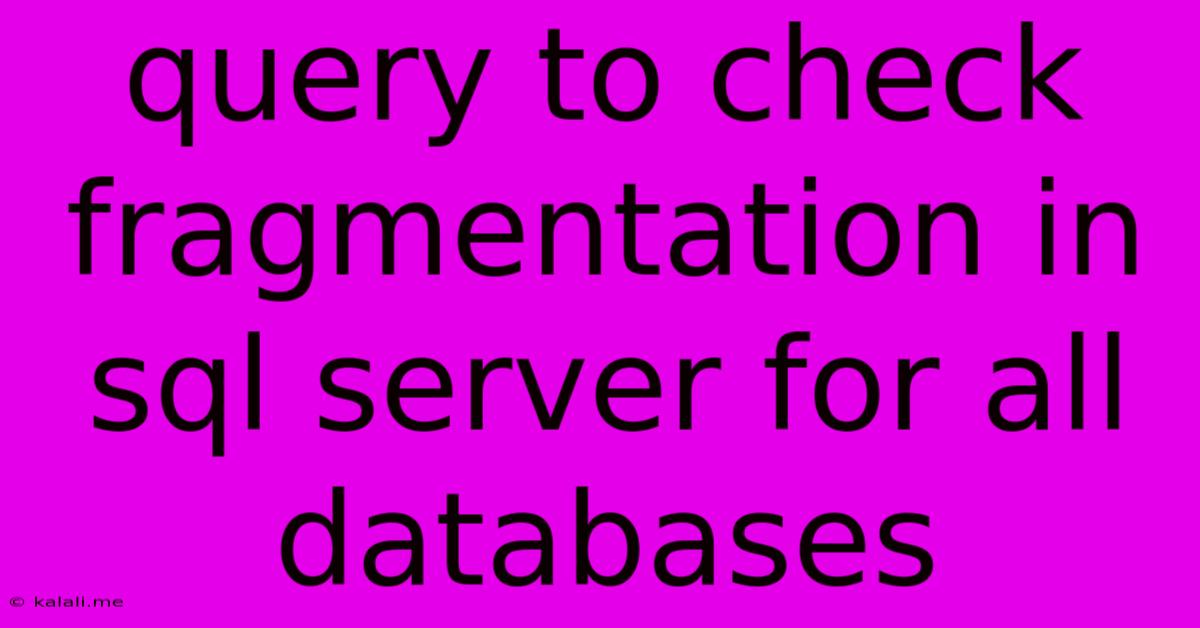Query To Check Fragmentation In Sql Server For All Databases
Kalali
Jun 05, 2025 · 3 min read

Table of Contents
Checking SQL Server Database Fragmentation: A Comprehensive Guide
This article provides a complete guide on how to check database fragmentation in SQL Server across all your databases. Understanding and managing fragmentation is crucial for maintaining optimal database performance. Fragmented indexes slow down query performance, leading to longer processing times and potentially impacting your application's responsiveness. This guide will equip you with the SQL queries needed to identify and address this issue.
Understanding Database Fragmentation
Before diving into the queries, let's quickly recap what database fragmentation is. Index fragmentation occurs when the data rows associated with an index are not stored contiguously on the disk. This leads to increased I/O operations when retrieving data, slowing down query execution. There are two main types:
- Leaf-level fragmentation: This refers to the fragmentation within the leaf pages of an index. Leaf pages contain the actual data pointers. High leaf-level fragmentation significantly impacts performance.
- Non-leaf-level fragmentation: This affects the upper levels of the index tree. While less impactful than leaf-level fragmentation, it can still contribute to performance degradation.
SQL Queries to Check Fragmentation
The following queries will help you assess fragmentation across all your databases. Remember to execute these queries as a user with appropriate permissions (e.g., sysadmin).
1. Identifying Fragmented Indexes across All Databases:
This query provides a comprehensive overview of index fragmentation for all databases on your SQL Server instance. It includes the database name, schema name, table name, index name, and the fragmentation percentage.
SELECT
DB_NAME() AS DatabaseName,
s.name AS SchemaName,
t.name AS TableName,
i.name AS IndexName,
p.index_id,
p.partition_number,
p.avg_fragmentation_in_percent AS AvgFragmentation
FROM
sys.dm_db_index_physical_stats (DB_ID(), NULL, NULL, 'DETAILED') AS p
INNER JOIN
sys.indexes AS i ON p.object_id = i.object_id AND p.index_id = i.index_id
INNER JOIN
sys.tables AS t ON i.object_id = t.object_id
INNER JOIN
sys.schemas AS s ON t.schema_id = s.schema_id
WHERE
p.avg_fragmentation_in_percent > 10 -- Adjust threshold as needed
ORDER BY
DatabaseName,
SchemaName,
TableName,
AvgFragmentation DESC;
This query uses sys.dm_db_index_physical_stats which is a dynamic management view providing detailed index statistics. The WHERE clause filters out indexes with fragmentation below 10%, allowing you to focus on those requiring attention. You can adjust this threshold based on your specific performance requirements.
2. Detailed Fragmentation Information for a Specific Database:
If you need a more granular view of fragmentation within a particular database, you can modify the query like this (replace 'YourDatabaseName' with the actual database name):
USE YourDatabaseName;
GO
SELECT
s.name AS SchemaName,
t.name AS TableName,
i.name AS IndexName,
p.index_id,
p.partition_number,
p.avg_fragmentation_in_percent AS AvgFragmentation,
p.fragment_count
FROM
sys.dm_db_index_physical_stats (DB_ID(), NULL, NULL, 'DETAILED') AS p
INNER JOIN
sys.indexes AS i ON p.object_id = i.object_id AND p.index_id = i.index_id
INNER JOIN
sys.tables AS t ON i.object_id = t.object_id
INNER JOIN
sys.schemas AS s ON t.schema_id = s.schema_id
WHERE
p.avg_fragmentation_in_percent > 5 -- Adjust threshold as needed
ORDER BY
SchemaName,
TableName,
AvgFragmentation DESC;
This focuses the results on a single database, enabling a more in-depth analysis of fragmentation within that specific context.
3. Identifying Highly Fragmented Indexes (Above a Certain Threshold):
You can further refine the queries to pinpoint severely fragmented indexes by adjusting the WHERE clause threshold. For example, to only show indexes with fragmentation above 30%:
-- Modify this for all databases or a specific database as shown above
SELECT ... WHERE p.avg_fragmentation_in_percent > 30;
Addressing Fragmentation
Once you've identified highly fragmented indexes, you can address the issue using SQL Server's built-in index maintenance functionalities, such as ALTER INDEX ... REBUILD or ALTER INDEX ... REORGANIZE. The choice between rebuild and reorganize depends on the severity of fragmentation. Rebuilding is more resource-intensive but provides a more thorough solution, while reorganizing is faster but less effective for severely fragmented indexes.
Remember to carefully plan your index maintenance tasks to minimize downtime and disruption to your applications. Scheduling these tasks during off-peak hours is generally recommended. Regular monitoring and proactive index maintenance are crucial for ensuring optimal database performance.
Latest Posts
Latest Posts
-
The Book Of Annals Of Solomon
Jun 06, 2025
-
Whole Wheat Vs Whole Wheat Flour
Jun 06, 2025
-
Can Low Oil Cause Knock Sensor Code
Jun 06, 2025
-
How To Write Height In Feet
Jun 06, 2025
-
How To Establish The Trigonometric Identity Calculator
Jun 06, 2025
Related Post
Thank you for visiting our website which covers about Query To Check Fragmentation In Sql Server For All Databases . We hope the information provided has been useful to you. Feel free to contact us if you have any questions or need further assistance. See you next time and don't miss to bookmark.